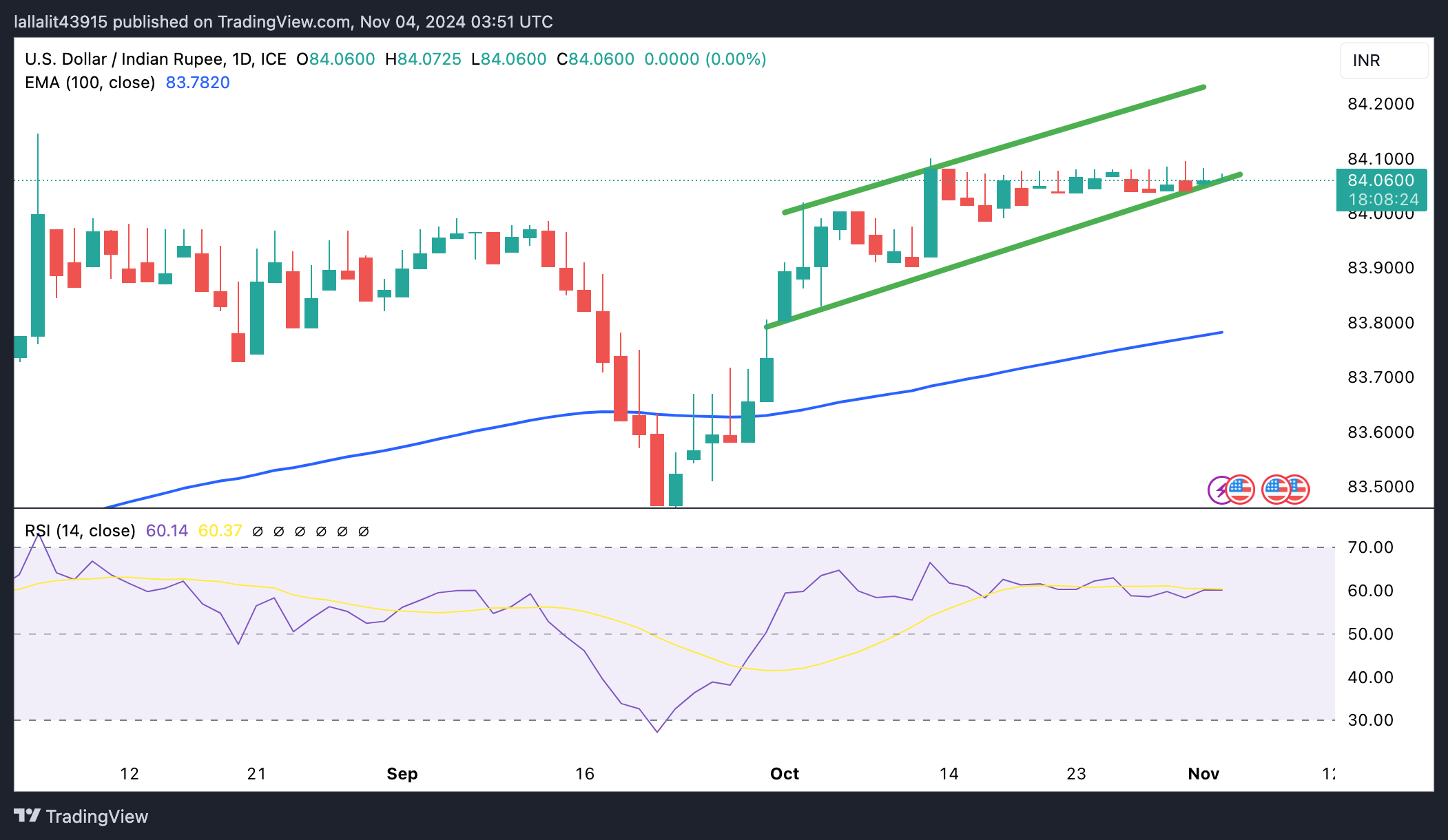- The Indian Rupee loses momentum in Monday's European session.
- The Indian HSBC Manufacturing PMI came in at 57.5 in October vs. 56.5 prior, stronger than expected.
- Persistent selling by overseas investors and higher crude prices weigh on the INR.
The Indian Rupee (INR) edges lower on Monday. The sustained foreign outflows from domestic stocks and rising crude oil prices exert some selling pressure on the local currency. However, the decline in the US Dollar (USD) amid the likely unwinding of long positions in the lead-up to the US presidential election might cap the INR’s downside.
The latest data released on Monday showed that the HSBC India Manufacturing Purchasing Managers Index (PMI) improved to 57.5 in October. This figure was above the market consensus of 57.4 and the previous reading of 56.5. The local currency remains strong in an immediate reaction to the upbeat PMI data.
The US presidential election and the Federal Reserve's (Fed) interest rate decision will be in the spotlight this week and might trigger volatility in the market. The Federal Reserve is widely anticipated to cut rates by 25 basis points (bps) at its November meeting on Thursday.
Daily Digest Market Movers: Indian Rupee weakens ahead of looming US presidential election
- The benchmark BSE Sensex and Nifty 50 equity indexes fell about 1.5% each on the day, pressured by likely selling by overseas investors and caution ahead of the US presidential election outcome.
- "India's headline manufacturing PMI picked up substantially in October as the economy's operating conditions continue to broadly improve," noted Pranjul Bhandari, chief India economist at HSBC.
- The Reserve Bank of India (RBI) is likely selling US Dollars near 84.1125-84.1150 rupee levels, per Reuters.
- According to a Reuters poll, the Indian rupee will trade in a tight range around current levels against the dollar over the coming year as the Reserve Bank of India (RBI) routinely dips into its FX reserves to manage the currency's stability.
- "The (FX) intervention has been an ongoing affair and it's not just this year, it's been continuing post-COVID so we would expect two-sided interventions to continue," noted Vivek Kumar, an economist at QuantEco Research.
- The Nonfarm Payrolls (NFP) in the US rose by 12K in October, following the 223K increase (revised from 254K) seen in September, the US Bureau of Labor Statistics (BLS) showed Friday. The figure was weaker than the market expectations of 113K by a wide margin.
- The Unemployment Rate held steady at 4.1% in October, in line with the consensus.
- "It is widely considered that a Trump win will be positive for the USD, though many feel this outcome has been discounted," noted Chris Weston, an analyst at broker Pepperstone.
Technical Analysis: USD/INR’s positive view remains in play in the longer term
The Indian Rupee trades weaker on the day. However, the bullish outlook of the USD/INR pair remains intact, with the price holding above the key 100-day Exponential Moving Average (EMA). The upward momentum is reinforced by the 14-day Relative Strength Index (RSI), which stands above the midline near 57.70.
The first upside barrier for USD/INR emerges at the upper boundary of the ascending trend channel of 84.24. Extended gains break above this level could draw in enough buying demand to 84.50, en route to the 85.00 psychological level.
On the downside, a decisive close below the lower limit of the trend channel near 84.05 could pave the way to 83.78, the 100-day EMA.
Indian Rupee FAQs
The Indian Rupee (INR) is one of the most sensitive currencies to external factors. The price of Crude Oil (the country is highly dependent on imported Oil), the value of the US Dollar – most trade is conducted in USD – and the level of foreign investment, are all influential. Direct intervention by the Reserve Bank of India (RBI) in FX markets to keep the exchange rate stable, as well as the level of interest rates set by the RBI, are further major influencing factors on the Rupee.
The Reserve Bank of India (RBI) actively intervenes in forex markets to maintain a stable exchange rate, to help facilitate trade. In addition, the RBI tries to maintain the inflation rate at its 4% target by adjusting interest rates. Higher interest rates usually strengthen the Rupee. This is due to the role of the ‘carry trade’ in which investors borrow in countries with lower interest rates so as to place their money in countries’ offering relatively higher interest rates and profit from the difference.
Macroeconomic factors that influence the value of the Rupee include inflation, interest rates, the economic growth rate (GDP), the balance of trade, and inflows from foreign investment. A higher growth rate can lead to more overseas investment, pushing up demand for the Rupee. A less negative balance of trade will eventually lead to a stronger Rupee. Higher interest rates, especially real rates (interest rates less inflation) are also positive for the Rupee. A risk-on environment can lead to greater inflows of Foreign Direct and Indirect Investment (FDI and FII), which also benefit the Rupee.
Higher inflation, particularly, if it is comparatively higher than India’s peers, is generally negative for the currency as it reflects devaluation through oversupply. Inflation also increases the cost of exports, leading to more Rupees being sold to purchase foreign imports, which is Rupee-negative. At the same time, higher inflation usually leads to the Reserve Bank of India (RBI) raising interest rates and this can be positive for the Rupee, due to increased demand from international investors. The opposite effect is true of lower inflation.
Information on these pages contains forward-looking statements that involve risks and uncertainties. Markets and instruments profiled on this page are for informational purposes only and should not in any way come across as a recommendation to buy or sell in these assets. You should do your own thorough research before making any investment decisions. FXStreet does not in any way guarantee that this information is free from mistakes, errors, or material misstatements. It also does not guarantee that this information is of a timely nature. Investing in Open Markets involves a great deal of risk, including the loss of all or a portion of your investment, as well as emotional distress. All risks, losses and costs associated with investing, including total loss of principal, are your responsibility. The views and opinions expressed in this article are those of the authors and do not necessarily reflect the official policy or position of FXStreet nor its advertisers. The author will not be held responsible for information that is found at the end of links posted on this page.
If not otherwise explicitly mentioned in the body of the article, at the time of writing, the author has no position in any stock mentioned in this article and no business relationship with any company mentioned. The author has not received compensation for writing this article, other than from FXStreet.
FXStreet and the author do not provide personalized recommendations. The author makes no representations as to the accuracy, completeness, or suitability of this information. FXStreet and the author will not be liable for any errors, omissions or any losses, injuries or damages arising from this information and its display or use. Errors and omissions excepted.
The author and FXStreet are not registered investment advisors and nothing in this article is intended to be investment advice.
Recommended content
Editors’ Picks

EUR/USD weakens below 1.0900 amid trade war fears
EUR/USD loses ground to trade below 1.0880 in early Europe on Thursday. Escalating US-EU trade tensions weigh on risk sentiment and the pair, lending some support to the US Dollar amid US inflation cooldown. Focus shifts to ECB-speak and US PPI data.

Gold price holds near record high; looks to US PPI for some meaningful impetus
Gold price sticks to its positive bias through the early European session on Thursday and remains close to the all-time peak touched on February 24. The chaotic implementation of US President Donald Trump's trade tariffs and their impact on the global economy continue to drive flows toward the safe-haven bullion for the third straight day.

GBP/USD stay defensive near 1.2950 as risk-off mood persists
GBP/USD is on the defensive near 1.2950 in the European session on Thursday. The pair faces headwinds from intensifying tariff war globally and a pause in the US Dollar downtrend. Traders look forward to the US PPI data for fresh directional impetus.

Ethereum: Staking could be catalyst to drive ETH's price 'more than Pectra upgrade': K33 Research
Ethereum traded around $1,860 in the Asian session on Thursday as its price remained largely subdued by bearish sentiment weighing on the general crypto market.

Brexit revisited: Why closer UK-EU ties won’t lessen Britain’s squeezed public finances
The UK government desperately needs higher economic growth as it grapples with spending cuts and potential tax rises later this year. A reset of UK-EU economic ties would help, and sweeping changes are becoming more likely.

The Best brokers to trade EUR/USD
SPONSORED Discover the top brokers for trading EUR/USD in 2025. Our list features brokers with competitive spreads, fast execution, and powerful platforms. Whether you're a beginner or an expert, find the right partner to navigate the dynamic Forex market.
